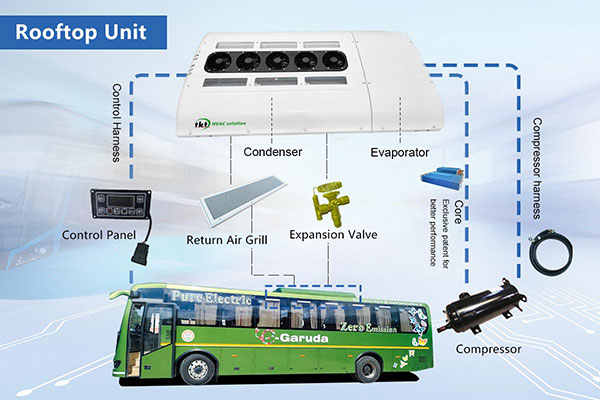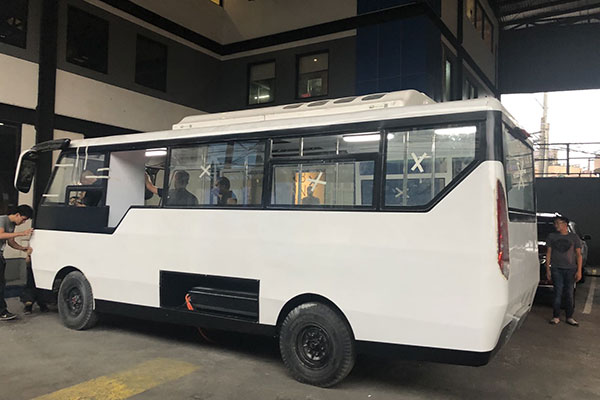A bus air conditioning system, also known as an HVAC (heating, ventilation, and air conditioning) system, is designed to provide comfort and maintain a pleasant temperature for passengers during both hot and cold weather conditions. The system typically consists of several major components: the compressor, condenser, evaporator, expansion valve or orifice tube, refrigerant, and electrical controls.

The Compressor:
The compressor is essentially the heart of the bus air conditioning system. It’s responsible for circulating the refrigerant throughout the entire system. When the thermostat signals that cooling is required, the compressor pressurizes and pumps low-pressure refrigerant vapor into the condenser. This component is usually driven by a belt connected to the engine, but some newer systems use electrically powered compressors.
The Condenser:
After leaving the compressor, high-pressure, high-temperature refrigerant gas enters the condenser. Here, heat from the refrigerant is transferred to the outside environment with help from ambient air passing through fins surrounding tubes carrying the heated refrigerant. As this process continues, the refrigerant changes state from a gas to a liquid due to decreased temperature and increased pressure. Once cooled sufficiently, it moves on to the next stage.
The Evaporator:
Following the condenser, the now cooler liquid refrigerant travels through an expansion device – either an expansion valve or orifice tube – which regulates the flow of refrigerant into the evaporator coil. Inside the evaporator, warm cabin air comes into contact with the chilled refrigerant causing it to absorb heat energy. Simultaneously, moisture from the humid air condenses onto the cold surface of the evaporator creating a dehumidifying effect inside the vehicle. After absorbing enough heat, the refrigerant turns back into a low-pressure vapor, ready to return to the compressor to repeat the cycle.

Expansion Valve vs Orifice Tube:
Both devices serve similar purposes; they control the amount of liquid refrigerant entering the evaporator. However, their operation methods differ slightly. An expansion valve uses a diaphragm controlled by a bulb filled with refrigerant from the outlet of the evaporator. As the temperature drops at the end of the evaporator, less refrigerant flows through the valve, maintaining optimal superheat levels within the evaporator. On the other hand, an orifice tube maintains a constant restriction regardless of changing operating conditions, relying on a metering rod to adjust flow based on the pressure difference across the two sides of the orifice. While simpler in design, orifice tubes can be less efficient than expansion valves under varying load conditions.
Refrigerants:
Refrigerants are critical to the functioning of any bus AC system. They have unique properties allowing them to change phase easily when subjected to different temperatures and pressures. Older systems used R-12 (Freon), but environmental concerns led to its phasing out. Modern systems primarily utilize R-134a, although new generations of lower global warming potential refrigerants like R-407C and R-410A are becoming more common.
Electrical Controls:
Various sensors and switches monitor system performance and ensure proper functionality. Key among these is the temperature sensor, which measures interior temperature and sends feedback to the control module, and the pressure switch, which safeguards against excessive system pressure. Additionally, climate control panels allow occupants to select desired settings such as fan speed, mode (e.g., floor, dashboard, defrost), and temperature. These inputs are processed by the electronic control unit (ECU), which manages operations accordingly.
Conclusion:
In summary, a bus air conditioning system relies on multiple interconnected components working together harmoniously to deliver comfortable temperatures for passengers despite external weather conditions. Through continuous circulation, compression, condensation, evaporation, and expansion of refrigerant, along with precise regulation via various sensors and controls, these sophisticated systems significantly enhance travel experiences.
TKT has a large factory engaged in the production and sales of bus air conditioners for more than 20 + years. We specialize in the production of Bus A/C, RV A/C, Parking A/C, BTMS systems, and DC Charging Piles. We provide design and technical support to the world’s leading OEMs, including BYD, Tata Motors, Switch Mobility, and more than 150 other outstanding companies. Welcome to contact us.


